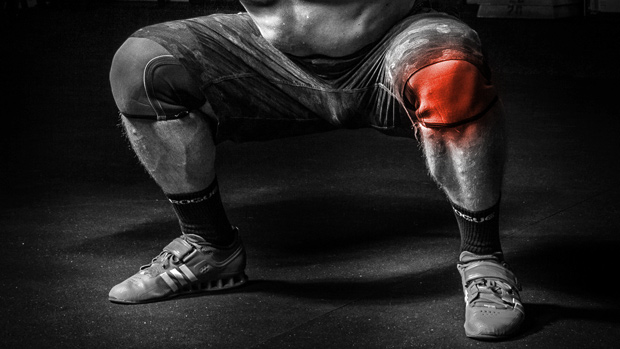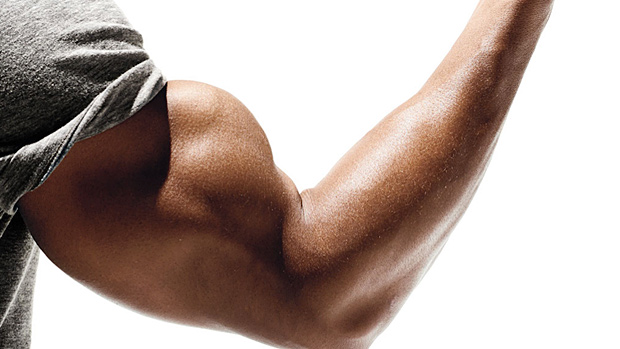5 Steps to Bulletproof Knees
Do your knees feel like they might explode every time you squat to parallel? Do they get stabby every time you lunge? If so, don't worry. You're not stuck with being an upper-body-only bro. And you don't have to go through life with a couple of flapjacks for an ass.
Your knees should be able to flex and extend pain free throughout a full range of motion when you squat. But if this isn't the case, you can do something about it. Here's your five-step plan for fixing achy knees.
To master a movement like the squat, you need to squat often. If you've got angry knees, that might sound worse than sitting on your own testicles, but try to squat 2-3 times per week.
But think beyond the back squat. You could also do front squats, split squats, goblet squats, or any other variation. Constantly varying your squats will keep you from overtraining one particular version of the squat.
Consider the back squat versus the front squat. Both are great ways to squat, but the emphasis is different. Your hips are more active in the back squat in comparison to the front squat. Your quads will be more dominant in the front squat.
Remember that a squat is a knee-dominant movement. In order to balance out your squat, you'll need to perform hip dominant (hip hinge) movements as well.
Do hip hinge exercises 2-3 times per week. The hip hinge can be deadlifts, trap bar deadlifts, kettlebell swings, good mornings, or other variations. They're great for the glutes. Strong glutes will keep your knees from caving in, which will prevent injury by helping you sit back on your heels as you squat.
Every solution to pain (when training) begins with sound programming followed by proper technique. Once you understand programming and technique you'll know WHY your pain exists. Once you've gotten your exercise programming together, take a closer look at your technique.
First off, people who say squats are bad for the knees likely don't know how to squat properly. When a squat is performed correctly, there should be no knee pain (barring a pre-existing condition).
When you squat, do the following during the descending portion of the lift:
- Stand with your feet shoulder width apart and your toes slightly pointed out.
- Push your hips back.
- Drive your knees out (see photo).
- Keep your heels flat.
- Make sure your back is strong and flat.

On the ascending portion of the squat:
- Drive your hips up and forward.
- Extend your knees pushing them outward.
- Drive through the three points of your foot: heel, big toe, and pinky toe.
- Keep your chest up.
Know what proper depth is, especially if you want to take credit for the amount of weight you squat. For our purposes, proper depth is achieved when the hips are either even with or slightly below the knees. If you can't squat to parallel, then you have mobility problems that need to be addressed.

There's a limit to how low you should go however. Don't force your body into a depth it's not ready for or you'll start to butt wink (third photo above) and could do some serious damage to your lower back. Butt wink is when your lower back rounds and your pelvis rotates back.
If you can't get your hips at knee level when squatting, you're doing a partial rep, which will primarily work the quads. And although there's nothing wrong with a partial squat if your goal is to nail the quads, full range of motion (ROM) should be your go-to depth.
Your glutes and hamstrings engage the most when you squat to proper depth. If you're going to parallel or below you can be sure that your glutes are firing. And when they do, you'll decrease the stress on your knees.
When it comes to your squat and the knee pain it causes, ankle mobility is the major culprit. If your ankles can't dorsiflex properly (toes flex toward shins – the motion your ankle naturally goes through when you squat) a lot of stress will be placed on your patellar tendon right under the kneecap.
To help your ankle dorsiflex when you hit your squat, do some soft tissue work before training. You can roll the calves with either the foam roller or barbell, but be warned: the barbell has some serious bite to it.
Calves

Place one foot on top of your shin to apply pressure on the calf against the foam roller or bar. Begin rolling the inside, middle, and outside of the calf, starting towards the ankle.
Hips, Hams, Quads
Now it's time to lube up those hips and thighs. If you don't have adequate hip mobility, you'll either have butt wink when you try to squat to parallel, or you won't hit parallel, which means your reps don't count, bro. Use a foam roller or lacrosse ball for the hips, a barbell for the quads, and a ball for the hamstrings.
Hips

Cross one leg over the other as you sit on the foam roller. Roll back and forth over the glutes and piriformis of the leg you have crossed.

Place the lacrosse ball in the side of the hip and draw small circles with your hip on the ball. Work your way from the side of the hip towards the tailbone.
Quads

Place a barbell at a 45 degree angle across the body. Beginning just above the knee, slowly roll the bar up the quad towards the hip.
Hamstrings

Sit on a hard flat surface and place lacrosse ball under your hamstring. Roll around on the ball until you find a tender area. Extend and flex your knee once you find an area of tension.
Now it's time to fire up your buns. Hitting some muscle activation for the glutes is a must if you want to squat without aggravating your knees. Although there are plenty of glute exercises you can do, the ones below are easy and don't require much setup. There's no need to get anal about your reps and sets here. These are just activation drills to help you use your glutes on the bigger lifts. Go by feel, but don't go crazy on them and tire yourself out with 500 reps.

Pull a mini band around your ankles. Step laterally left and right, putting tension on the band.

Assume a tabletop position. Keeping your knee bent, raise one leg out to the side.

From the tabletop position, fully extend your hip and knee backwards, then draw big circles with one leg.

Assume a tabletop position with one leg extended out to the side. Keeping your knee straight and using just the hip, lift your leg off the floor.
Don't forget about stretching after your workout. Hold stretches for a longer period of time while your muscles are still warm and receptive. These will help get rid of the kinks in your keister and it'll help prevent those kinks from cropping up again.
Glutes and Hips

This is called the standing pigeon stretch. Place one leg across a box at a 90 degree angle. Press your opposite hip forward and rotate the hip that's on the box backward.
Hips and Hip Flexors

Do the lizard lunge with external rotation. Place one foot in front of you so that your knee is behind your shin. Extend your opposite leg behind you. Roll to the outside of your foot and press your knee away from your body.
Hips and Thoracic Spine

Do the squat hold with a reach back. Keeping your heels flat, squat down as deep as you can comfortably hold. While keeping you heels flat, reach one arm up as you try to touch your bicep to your ear.
Ankles and Calves

Place a resistance band around your ankle and loop the other end around a fixture. Keep your heel flat as you push your knee forward so that it goes past your toes. The band will pull your shin backwards, creating a stretch in your ankle.
Look at the amount of plyometrics you're doing. When we jump, gravity is pulling us down with a force that's 1.5 to 3 times greater than our bodyweight. That's a lot of impact even if you don't currently possess extra junk in the trunk. The impact from landing can take a toll on your joints, especially if you're not landing properly.

This doesn't mean you have to avoid jumps. Just know when to apply them to increase your strength and prevent injury. Do NOT do endless reps of plyometrics as a conditioning tool at the end of your workout. You'll be tired by the end of your workout and your landing form will suck balls. There are plenty of other exercises you can do to condition your body that won't leave you with scabby shins and angry knees.
Do use plyo as tool to activate your nervous system before you lift. Doing a whole body movement like a jump, which requires the muscles to contract quickly, is a great way to prepare your nervous system to lift heavy things.
If you're going to do any sort of jumps to get primed before squatting, make sure you're landing the right way. Check for the following:
- Your shoulders are in line with your knees.
- You're landing on the balls of your feet.
- Your knees track outward when you land.
- Your back is strong and flat.
Landing with good mechanics goes a long way toward making sure you don't ruin the next six months of your life with an ACL tear.





